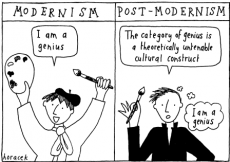
Email: reecejordan98@hotmail.co.uk
Total Article : 168
About Me:18-year-old sixth form student, studying English Literature, History and Government and Politics. My articles will broadly cover topics from the current affairs of politics to reviews of books and albums, as well as adding my own creative pieces, whether it be short fiction or general opinion.

Irony, Playfulness and Black Humour:
1) Postmodern humour responds to and references the fears, fixations, frameworks and technologies which underpin our postmodern existence.
2) Several novelists later to be labelled postmodern were first collectively labelled black humourists: John Barth, Joseph Heller, William Gaddis, Kurt Vonnegut, Bruce Jay Friedman, etc.
3) Many post modernists used humour to explore serious topics and event.
Intertextuality:
1) Intertextuality in postmodern literature can be a reference or parallel to another literary work, an extended discussion of a work, or the adoption of a style.
2) In postmodern literature this commonly manifests as references to fairy tales – as in works by Margaret Atwood, Donald Barthelme, and many others – or in references to popular genres such as sci-fi and detective fiction.
3) There are all kinds of techniques that authors can use in order to highlight these links, including pastiche, parody, quotes, and direct references, as well as subtler nods to other material.
Pastiche:
1) Related to postmodern intertextuality, pastiche means to combine, or "paste" together, multiple elements.
2) In Postmodernist literature this can be an homage to or a parody of past styles. It can be seen as a representation of the chaotic, pluralistic, or information-drenched aspects of postmodern society.
3) It can be a combination of multiple genres to create a unique narrative or to comment on situations in postmodernity: for example, William S. Burroughs uses science fiction, detective fiction and westerns.
Metafiction:
1) The word "metafiction" signals the kind of text that emphasizes its status as a text -metafiction is 100% aware of the fact that it's fiction.
2) There are lots of different ways in which authors can create this effect—story-within-a-story, making obvious references to storytelling conventions—but what they have in common is that they call attention to the processes of writing and reading.
3) Linda Hutcheon came up with the term "historiographic metafiction" in 1988. The term describes fictional texts that bring history into the mix—a combo that takes us away from the idea of history as fact and highlights that writers can put their own spin on things (after
4) Fabulation, much like metafiction, challenges some traditional notions of literature—the traditional structure of a novel or role of the narrator, for example—and integrates other traditional notions of storytelling, including fantastical elements, such as magic and myth, or elements from popular genres such as science fiction.
5) Poioumenon is a term coined by Alastair Fowler to refer to a specific type of metafiction in which the story is about the process of creation. . An example of this Is Laurence Sterne's, Tristram Shandy, which is about the narrator's frustrated attempt to tell his own story.
Temporal Distortion:
1) This is the fragmentation and distortion of time.
2) Time may also overlap, repeat, or bifurcate into multiple possibilities. For example, in Robert Coover's "The Babysitter" from Pricksongs & Descants, the author presents multiple possible events occurring simultaneously—in one section the babysitter is murdered while in another section nothing happens and so on—yet no version of the story is favoured as the correct version.
Magic Realism
1) Portrays magical or unreal elements as a natural part of in an otherwise realistic environment.
2) Dreams, myths and fairy stories
3) Gabriel Garcia Marquez – One Hundred Years of Solitude
Technoculture and Hyperreality
1) Technological inundation – failing to acknowledge the difference between simulation and reality.
Paranoia
1) The belief or sense that there is an ordering body behind the chaos of the world – can be in the form of delusion or adept insight.
Maximalism
1) Similar to modernist convention of a fragmented narrative – critiqued for involving vacuous wordplay.
Minimalism
1) Representation of only the basic and necessary pieces.
2) Allows the reader to shape the story.
3) Most commonly associated with Jon Fosse and Samuel Beckett
Fragmentation
1) In terms of narrative, time, character development etc.
2) Also seen in modernism
Image Credits: quora.com

0 Comment:
Be the first one to comment on this article.